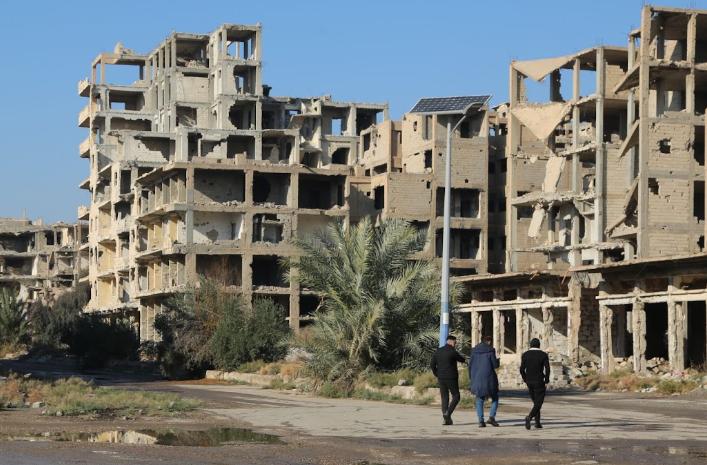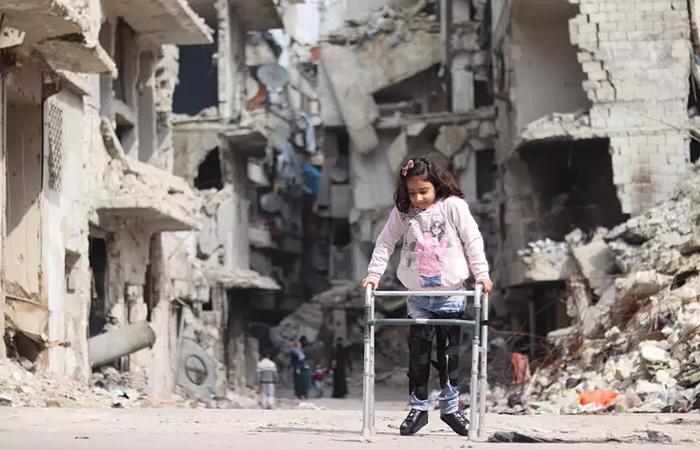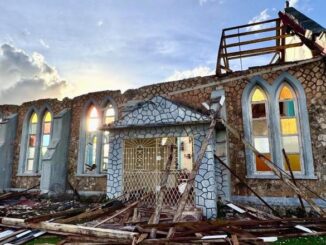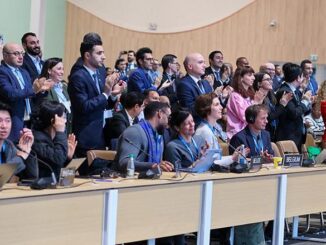
DAMASCUS, Syria, May 28, 2025 (ENS) – Landmines and explosive ordnance from 14 years of conflict are still spreading their deadly contamination, creating a humanitarian emergency across Syria, the United Nations and other humanitarian agencies are urgently warning.
Following the collapse of the Bashar al-Assad regime last December, communities and families desperate to return home and resume their lives are facing a new threat – the presence of landmines and unexploded ordnance, UXO.
Cluster munitions and air dropped bombs are buried in the rubble of war and litter roads and fields. Explosive remnants of war, called ERW, munitions that failed to explode after being fired, or others abandoned by fighters, still lie where they fell.
Improvised explosive devices were deployed by ISIS in the province of Deir ez-Zor and the city of Raqqa, often in abandoned homes, vehicles, and infrastructure.
All these explosives pose a deadly threat to children at play, people going about their daily lives, and especially to people hunting for truffles in the desert, a popular and lucrative activity in truffle season, late winter and early spring.
In March, 19 people searching for truffles in the north Syrian desert were killed when their small truck hit a landmine in Raqa province, the Syrian Observatory for Human Rights said.
As internally displaced people and refugees from neighboring countries move about Syria their movements have increased the casualties due to landmine and UXO, humanitarian agencies warn.
The UN’s commission of inquiry on the Syrian Arab Republic estimates that between 2011 and May 2021, more than 580,000 people were killed; with 13 million Syrians being displaced, and 6.7 million refugees forced to flee Syria.
Just today in Deir ez-Zor province, a child died and five others were injured after a projectile of war remnants exploded while they were playing with it in the city of Al-Asharah, within an area held by the new government.
The UN Office for the Coordination of Humanitarian Affairs, UNOCHA, reports that from December 2024 through the end of February 2025, 463 landmine and ERW casualties occurred in Syria, killing 158 people and injuring 305. One third of those casualties were children.
One international security monitor has recorded some 900 victims, many of them children, since December.

These casualties from a five-month period represent 15 percent of the casualties reported globally across more than 50 countries in 2023, according to The Mines Advisory Group, or MAG, a global humanitarian and advocacy organization that finds, removes and destroys landmines, cluster munitions and unexploded bombs from places affected by conflict.
MAG provides education programs, especially for children, so people can live, work and play as safely as a possible until they can clear the land of explosives. Since 1989, MAG has helped over 20 million people in 70 countries rebuild their lives and livelihoods after war.
“We believe it is unacceptable that millions of people are trapped in danger and poverty for years after wars end. We aim to help communities get on with their lives, and get back their futures,” MAG says on its website.
MAG that the situation in Syria represents “the greatest humanitarian impact of landmines and unexploded ordnance anywhere in the world.” The group bases its assessment on first hand evidence from recent assessments, the high number of recorded accidents, and extensive experience in emergency contexts.
An urgent response is required to save lives, MAG insists.
MAG has signed a memo of understanding with the Syria Civil Defense, known as the White Helmets, to scale up delivery of risk education as well as survey and clearance work, and the groups are exploring further partnership opportunities.
The White Helmets was founded in 2013 in Syria by volunteers who aimed to respond to aerial and land bombings and reduce the gap left by the al-Assad regime’s withdrawal of basic government services such as firefighting and healthcare.

To provide “an appropriate response across the whole of Syria,” MAG says that it will need an increase in funding from current levels of about US$6 million a year to about $25 million.
Cluster munitions were extensively used in the cities of Hama, Homs, Aleppo and in the Damascus suburbs. Air-dropped bombs were deployed in Raqqa, Deir ez-Zor and Aleppo, often leading to massive UXO contamination.
Conventional anti-personnel and anti-tank mines were extensively laid around military positions, fluctuating frontlines and along strategic road networks.
Few parts of the country are untouched, MAG reports. In the city of Aleppo, there is extensive urban destruction and the presence of UXO from battles that took place between 2013 and 2016.
In Hama, there is heavy contamination due to prolonged conflict, cluster strikes and multiple belts of landmines, while the three-year siege of Homs, from 2011 to 2014, resulted in large-scale UXO and cluster munition remnants.
MAG points to the devastated Damascus suburbs of Harasta, Irbin and Jouba, where whole neighborhoods were reduced to rubble and where former residents are attempting to return to any homes that remain habitable. But there are almost certainly lethal levels of contamination.
The Mines Advisory Group has been working in Syria since 2016 and is the largest and most experienced mine action actor in the country with more than 220 staff, and teams deployed across Al-Hasakah, Raqqa and Deir-Ez-Zor in the northeast of the country.
A senior medic at a trauma centre in northern Syria describes the number of casualties from landmine and explosive ordnance accidents in the country as a “humanitarian emergency.”

Head of Nursing at Idlib Surgical Specialised Hospital, Hamed Osman says the influx of patients with serious and sometimes fatal injuries is overwhelming.
“Four people every day, on average, are being brought into just this one hospital because of landmine or explosive ordnance accidents. It is like a flood,” Osman said.
“We worry it will get worse as more people return and as more people try to reclaim their land, begin farming or try to rebuild their homes.”
Speaking during a visit to the centre by MAG teams at the end of April, Osman said, “Since December we have treated almost 500 landmine accident patients. About 60 patients died and many have lost limbs. Very sadly, 68 of those patients were children and five of those children have died.”
“We used to deal with war injuries. We thought it was over but now we have another war to deal with.”
Osman says that because people feel like they have no choice but to return to their land and to farm to earn money, urgent work is needed to make people aware of the risks of landmines and explosives. “Every day, lives are being lost because we are not taking enough action and people are not being made aware of the danger,” he said.
Many of the accidents are taking place in remote areas, where people are farming. The cost of the operations and caring for patients is creating a huge burden, he said.
Osman urged immediate action, saying, “We need risk education now and we need teams to begin to mark the dangerous land and to begin clearing the priority areas near people’s homes so they can safely return and so people can access their farmland.”
Featured image: Ruins of the historic Sarouja souk in Old Damascus, Syria, July 2023 (Photo courtesy Syrian Opposition Coalition)



